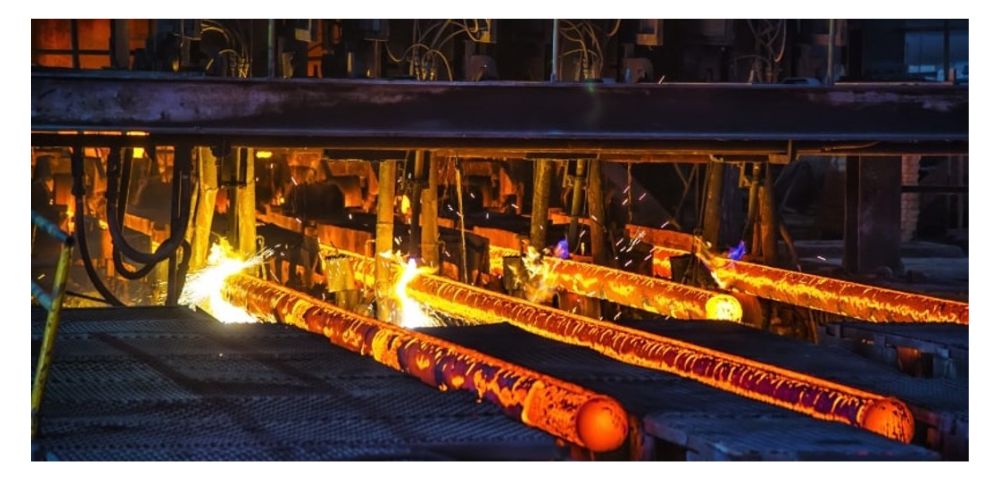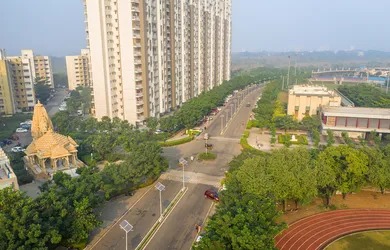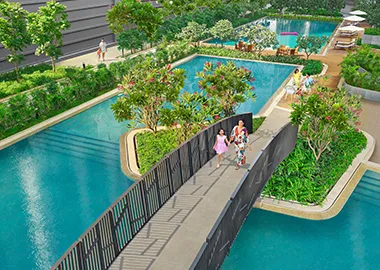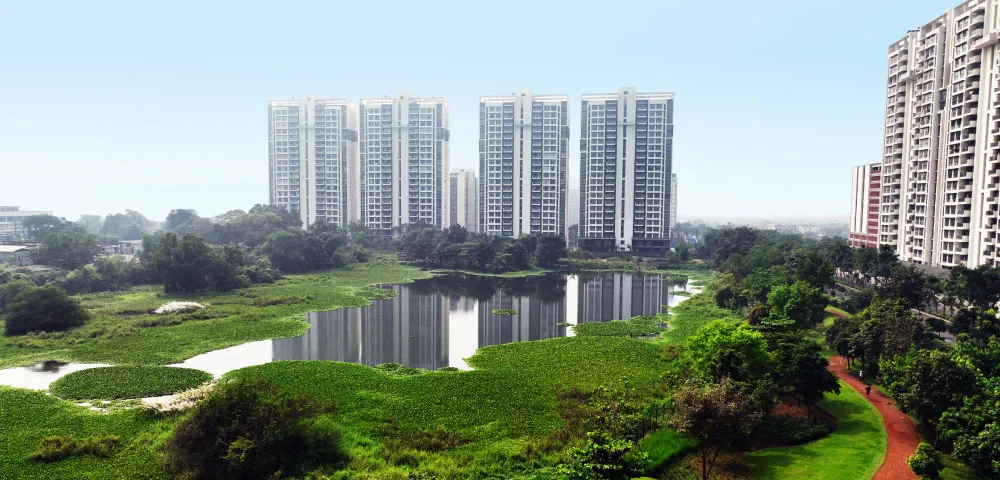The Rebar Opportunity: Decarbonising the Backbone of India's Construction
By sai sri harsha pallerlamudi, tarun garg, zoya zakai – rmi india foundation, aun abdullah – lodha
July 30, 2025

Walk through any Indian city, and the skyline tells a story of ambition. Soaring residential towers and sprawling commercial hubs are tangible symbols of a nation on the move. At the heart of this urban transformation lies steel reinforcement bar, or rebar. It is the hidden skeleton that gives strength and durability essential for buildings and infrastructure - the literal backbone of modern India.
Yet, this essential component carries a heavy, invisible burden—a significant carbon footprint that could make or break India's decarbonisation goals.
To strengthen our efforts towards responsible steel sourcing, we engaged strategically with producers through site visits to steel plants across Maharashtra and Tamil Nadu. We also launched a cross-sector dialogue through a webinar series that convened stakeholders across the value chain to discuss barriers and opportunities for low-carbon rebar adoption. The first webinar delved into market dynamics, procurement strategies, and the potential of recycled steel, while highlighting key challenges around data availability and cost premiums. The second webinar focused on innovations in steel production, digital innovation and emissions tracking.
This collaborative effort, undertaken through our Net Zero Urban Accelerator—a partnership with RMI India Foundation—generated valuable insights into India’s evolving recycled steel ecosystem and presented practical, near-term pathways to decarbonising rebar.
The most important insight from this exercise is that recycled steel produced via electric furnaces, when supported by a carefully managed scrap mix, renewable electricity, and a robust quality control setup, offers a faster and more practical pathway to decarbonising rebar production in India. In contrast, emerging solutions such as hydrogen-based reduction and carbon capture, utilisation and storage (CCUS) remain technologically immature, capital intensive, and years away from commercial viability at scale. Given India’s current infrastructure and scrap availability, improving the performance and emissions profile of the existing electric furnace ecosystem presents the most immediate opportunity to reduce embodied carbon in construction steel.
The Scale of the Challenge
Long product category accounts for about 50% of India's 162 million tonnes annual finished steel production, making it the single largest steel product category in the country [1] [2]. Traditional steel production, dominantly reliant on coal-fired blast furnaces along with coal-based direct reduction of iron, is carbon-intensive, contributing to approximately 10-12% of India’s CO2 emissions - with an intensity near 2.5 t CO₂ per tonne of crude steel [2].
Furthermore, as India is set to double its floor space in the next two decades and each new project locks in decades of embodied carbon unless we fundamentally rethink how we source and specify steel [3]. This massive scale presents one of the most significant opportunities for mass-market decarbonisation. Every column, beam and foundation laid is a chance to choose a lower-carbon alternative. Given it’s scale and dominance, transformation of the rebar market is a critical and achievable first step in the broader decarbonization of India's construction and steel sectors.
Why Rebar Is Different—And Why It’s The Perfect Starting Point
Not all steel is created equal, and rebar is the ideal product to lead this transition. Unlike exposed steel products used in cars or appliances that demand pristine finishes and ultra-precise specifications, rebar is embedded in concrete, where it is naturally protected. This makes it more forgiving in terms of surface quality and finish, offering greater flexibility to adopt lower-emission, high quality production routes without compromising performance.
- Technical Feasibility: The quality specifications for rebar are perfectly achievable through the scrap based, electric furnace route– a significantly less carbon-intensive process than traditional coal-based blast furnaces (BF-BOF). Concerns around higher scrap usage—such as variability in composition or impurity levels—can be effectively managed through advanced secondary metallurgy practices. For example, Ladle Refining Furnace (LRF) technology enables precise control over chemical composition and inclusion removal, reducing phosphorus content by up to 90% (from 0.1% to 0.03%) and sulphur from 0.07–0.08% to as low as 0.007%, ensuring compliance with IS:1786 standards [4]. To ensure structural and durability performance, a comprehensive suite of mechanical and chemical tests is conducted during and after production—including ultimate tensile strength (UTS), yield strength, elongation, bend tests, TM-Ring test as well as spectrometric analysis to verify alloying elements and residual content.
- Developing Supply Chains: India's domestic scrap supply is growing. Domestic ferrous scrap recovery is about 25Mt/yr, and imports reached ~9.4 Mt in 2024 [2]. The government aims to raise the scrap share in steelmaking from ~15% today to 50% by 2047, spurring mills like Tata Steel, JSW and SAIL to add electric furnace capacity [5]. EAFs now account for ~22% of India's steelmaking capacity, with several upcoming new scrap-based plants—including Tata's 0.75 Mt/yr EAF in Punjab and SAIL's 1.5 Mt/yr EAF by 2029 [1] [6] [7]. Furthermore, the government's Vehicle Scrappage Policy coupled with the natural end-of-life cycle for old buildings and infrastructure, will create a robust domestic source of steel scrap, reducing import dependence.
- Scale: The sheer volume of rebar consumed in India's construction sector means that even a partial shift in procurement can have an outsized impact on national-level emissions. Leading primary steel producers allocate only 10–15% of their output to TMT rebars, most of which is directed towards infrastructure and high-rise construction [8] [9] [10]. In contrast, a large share of rebar used in general construction comes from the recycled/secondary steel production route using electric furnaces. While precise estimates are hard to come by, it is likely that as much as 80% of all steel used in rebar production comes via the electric furnace route, and 20% sourced from BF-BOF or integrated plants by leading steel manufacturers. This presents a powerful opportunity to enhance quality and decarbonise this crucial segment of steel consumption through greater use of high-quality scrap and integration of renewable energy in electric furnaces. If pursued strategically, this pathway can achieve near-zero emissions decades ahead of the broader steel industry’s decarbonisation timeline.
Pathways to Decarbonisation: Scrap & Renewables
Green hydrogen and CCUS may headline future steel narratives but face technical and economic hurdles that delay widespread adoption. In contrast, scrap-based rebar production powered by renewables is a proven, scalable technology available today.
Bypassing the need for iron ore and coking coal, the electric furnace route (electric arc and induction furnaces) slashes emissions at the source. India’s current steel production using electric furnaces emits over 2 tCO₂ per tonne of TMT. By 2030, emission intensity can be significantly reduced to <1 tCO₂/tTMT through greater use of scrap and renewable electricity. With continued grid decarbonisation and process optimisation, deeper reductions close to 0.5 tCO₂/tTMT by 2035. By 2040 and beyond, as technologies like green hydrogen and CCUS mature and scale, they will pave the way for near-zero emission steel production.
Bulk Buyers as Market Drivers
Bulk buyers hold the key to unlocking this opportunity. The construction and infrastructure sector consumes 68% of India's steel production [1]. Rebar, beyond its structural function, presents a powerful lever to decarbonise India's built environment. Real estate and infrastructure players, as bulk buyers of steel, are uniquely positioned to shape the market. By embedding emission intensity criteria in procurement, forming partnerships with progressive suppliers, and leveraging digital tools for emission tracking, developers can create visibility and pull for greener rebar supply chains.
Understanding the "Green Premium"
A common misconception is that low-carbon rebar carries a steep price premium of 15-20%. In reality, with higher scrap utilization, renewable energy contracts, and process optimization, the true premium for green rebar may be as low as 3–5%.
- Scrap drive cost benefits: Every ton of scrap can potentially save 1.1 tons of iron ore, 630 kg of coking coal and 55 kg of limestone. Additionally, specific energy consumption can be reduced by 16-17%, while water consumption and greenhouse gas emissions can be reduced by 40% and 58% respectively [11]. Optimising scrap procurement and processing can potentially reduce raw material costs by 10-20%, depending on scrap prices.
- Renewables Integration creates competitive advantage: In practice, electric furnace plants using 100% scrap have almost no process CO₂ (only electricity), especially if powered by renewables. Electric furnaces use higher electricity consumption (EAF-664kWh/ton, IF-675-825kWh/ton) for steelmaking, compared to BOF (174 kWh/ton) ([4]. While this seems disadvantageous, it creates opportunity for large-scale renewable electricity PPAs, Open-access arrangements, captive plants, and green power markets that provide 15-25% cost savings over grid power. With falling renewables prices, scrap-based steel gets increasingly cost-aligned with conventional rebar.
- Process innovation drives efficiency: Modern innovations like direct hot charging eliminate the need to cool and reheat steel billets. Now, ~90% of Induction Furnace plants use direct rolling, eliminating cooling and reheating. This saves ~30 litres of Light Diesel Oil (LDO) per billet, cutting ~90 kg of CO2 emissions ([4]. Modern EAF technologies, coupled with digital monitoring and waste heat recovery systems, are continuously improving energy efficiency and material yield, further driving down production costs.
As carbon pricing mechanisms gain traction and green building certifications become market differentiators, low-carbon materials offer even better competitive advantages.
Government Support and Policy Framework
India's commitment to steel sector decarbonisation is strengthening through comprehensive policy initiatives. The recently unveiled Green Steel Taxonomy for Indian steel (setting CO₂ thresholds for 3★–5★ ratings) marks a historic milestone, making India the first nation to release such comprehensive green steel guidelines. Recently released Clean Technology Substitution (CTS) targets for the steel sector also provide a formal push for adopting lower-emission production technologies.
The Steel Scrap Recycling Policy and emerging incentives for green steel production further underscore India’s push toward circularity. With global competition for scrap intensifying—many countries are now restricting exports—India is actively strengthening its domestic collection systems. Major steelmakers now even jointly run scrapping centres (e.g. government and industry joint-ventures for end-of-life vehicles). Government initiatives – from vehicle scrappage schemes to digital scrap exchanges – are steadily increasing scrap availability.
At the same time, Green building rating systems are also evolving to reward low-carbon material choices, including recycled steel. The market pull for low-carbon rebar is set to strengthen, both from domestic policy and from international pressures like the EU’s upcoming Carbon Border Adjustment Mechanism.
The Path Forward: Scaling What Works
Rebar represents a ready-now opportunity for immediate and scalable decarbonisation in India's steel and construction sectors. While the path to a fully decarbonised steel industry may be long, scrap-based electric furnace rebar provides a practical way to cut emissions at scale today, not decades from now. As hydrogen and carbon capture await cost breakthroughs, the rebar opportunity offers more than incremental gains. It is a chance to fundamentally reshape the carbon footprint of Indian construction. It offers market scale, technical readiness through established scrap-based production routes, and economic viability with manageable cost premiums due to efficiency gains and renewable energy uptake.
For developers, acting on rebar decarbonisation is both a climate imperative and a strategic opportunity. It enables early compliance with emerging regulations, aligns with national climate priorities, and contributes meaningfully to India’s net-zero goals. Those who act now won’t just future-proof projects, they’ll build the literal foundations for a low-carbon built environment.
References
[1] Ministry of Steel, “Annual Report 2023-24 Government Of India,” 2024. Available : https://steel.gov.in/sites/default/files/2025-04/Annual%20Report%202023-24%20Final_0.pdf
[2] Ministry of Steel, “Greening the Steel Sector in India Roadmap and Action Plan,” 2024. Available: https://steel.gov.in/sites/default/files/2025-03/GSI%20Report.pdf
[3] RMI, NIUA, “From the Ground Up,” 2022. Available: https://rmi.org/wp-content/uploads/2022/11/decarbonising_from_the_ground_up.pdf
[4] Zoya Zakai, Harsha Pallerlamudi, Tarun Garg, and Aun Abdullah, “Accelerator Dialogues | Advancing Ambition: Breakthrough Technologies and Solutions Shaping the Steel Sector.” Available: https://www.lodhagroup.com/blogs/sustainability/advancing-ambition-breakthrough-technologies-solutions-steel-sector
[5] PIB, “Special Service and Features,” 2023. Available: https://www.pib.gov.in/PressReleseDetailm.aspx?PRID=1896312
[6] GMK, “India’s SAIL and JCIL to invest $692 million in electrical steel production.” Accessed: Jul. 24, 2025. Available: https://gmk.center/en/news/indias-sail-and-jcil-to-invest-692-million-in-electrical-steel-production/
[7] TATA Steel, “Tata Steel signs MoU with Punjab Government to set up a steel scrap based electric arc furnace steel plant.”Available: https://www.tatasteel.com/media/newsroom/press-releases/india/2022/tata-steel-signs-mou-with-punjab-government-to-set-up-a-steel-scrap-based-electric-arc-furnace-steel-plant
[8] TATA, “Integrated Report and Annual Accounts,” 2025. Available : https://www.tatasteel.com/media/23973/fy25-integratedreport.pdf
[9] JSW, “Integrated-Annual-Report-FY-2024-25,” 2025. Available: https://www.jswsteel.in/sites/default/files/assets/downloads/steel/IR/Financial%20Performance/Annual%20Reports%20Steel/24-25/Integrated-Annual-Report-FY-2024-25.pdf
[10] SAIL, “Annual Report,” 2024. Available : http://sail.co.in/sites/default/files/ticker/2024-09/SAIL_Annual_Report2023-24.pdf
[11] Ministry of Steel, “Steel Scrap Recycling Policy ,” 2019. Available: https://steel.gov.in/sites/default/files/2025-03/steel-scrap-recycling-policy.pdf
You may also like



 Enquire
Enquire
 Call
Call
 chat
chat
 Search
Search





